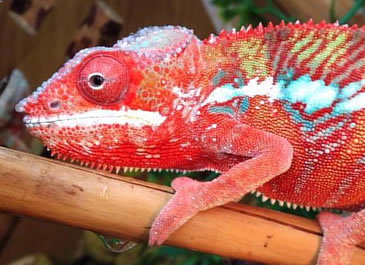The panther chameleon (Furcifer pardalis) is a subspecies of chameleon and it is usually found in the rainforests of northern and eastern Madagascar. Males are likely to be twice in length as compared to females. The body is a combination of many different colors and it mainly depends on the location and habitat.
Panther Chameleon Facts
Anatomy
- Adult males can reach a length of about 20 inches in total length but the mean length measures around 17 in (45 cm). Females grow no more than 9 – 10 inches in length.
- Males are likely to show vibrant colors than females. However it’s the location that primarily determines the color of the body. While some species show blue-colored body others are recognized by their green, orange or red skin.
- The population living in Tamatave and Maroantsetra seem to show reddish body.
- Adult females are distinguished by their tan body along with a little combination of peach or bright orange.
- Like typical chameleon, the panther chameleons have feet that are adapted to gripping onto narrow branches. The grip is so tight that they never fall.
- Unique among its features is the chameleon’s eyes that move independently. That is to say they may be looking at two different sceneries at the same time. Turns out the panther chameleon rely on vision to escape predator.
- If the prey is located then chameleons fix their eyes in order to have a good look at it.
- They have got one of the keenest eyesight of all reptiles. Panther chameleons are capable to see things from a distance of 5 – 10 meters.
- Chameleons are thought to possess long tongues which at times grow bigger than the entire body length. It strikes the prey within a fraction of a second giving little or no time to escape. The panther chameleon hits the prey in 0.003 second.
See also: Chameleon Facts For Kids

Behavior
- While chameleons have long been admired for their camouflaging ability sometimes the facts about its color are highly exaggerated. It’s true that they change their colors with respect to the surroundings but they do possess natural color. One cannot expect every chameleon species to produce every type of color for camouflaging.
- Panther chameleons may change its body color not necessarily to match with the surroundings but mood, light and temperature also reflects on the animal’s appearance.
- The panther chameleon does not possess purple color and thus they are unable to turn purple no matter what.
- They are highly territorial in the wild.
- Chameleons are solitary species except during the breeding season.
- Males will often fight with each other to win the female. Only the dominant male must mate with a female.
- The panther chameleon makes very popular pets and if they’re housed properly they may live longer than expected.
Range & Habitat
- Panther chameleons are likely to survive in the coastal areas of Madagascar. They have also been introduced on the islands of Mauritius and Reunion. The chameleon’s range extends north-western Madagascar, north-eastern and central-eastern region of the country.
- It makes home in a lowland humid habitat.
Feeding Ecology & Diet
- In captivity the panther chameleon is thought to consume wax worms, roaches, and meal worms.

Reproductive Biology
- The breeding occurs from October to March.
- The panther chameleon is likely to attain maturity at 7 months of age.
- The clutch size is about 10 – 40 eggs. The mean clutch size is about 16 – 24 eggs.
- A female lays 5 – 8 clutches of eggs during her entire lifetime.
- The average life expectancy of a female panther chameleon is about 2 – 3 years. This is because of the stress they go through during reproduction.
- The gestation period lasts 14 – 21 days.
- The female covers the eggs with a layer of soil.
- The maximum lifespan of panther chameleons is about 2 years in the wild.
- The hatching period lasts about 8 months.
Conservation Status
Least Concern






Leave a Reply